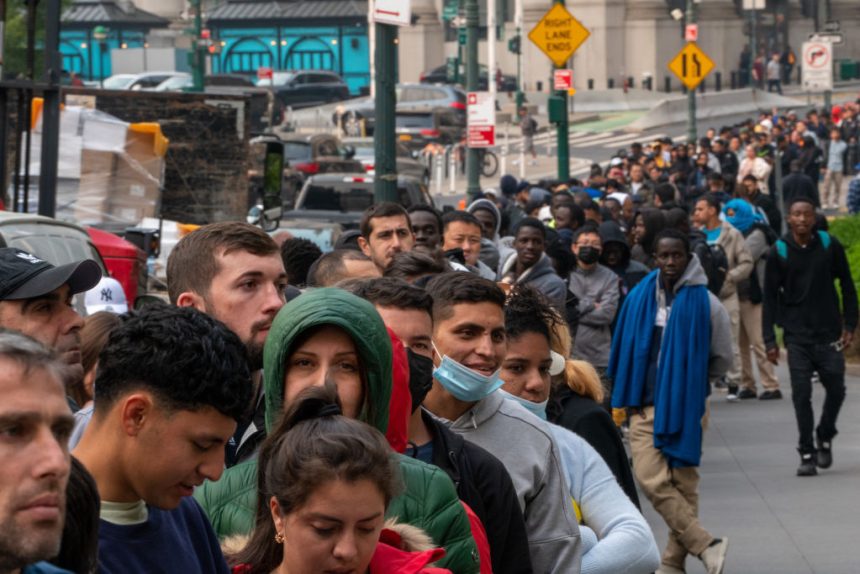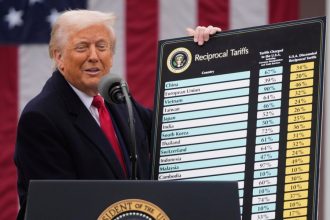Hundreds of asylum-seekers line up outside the Jacob K. Javits Federal Building in June 2023 in New York City. Most refugees and asylees will no longer be able to get food stamps under President Donald Trump’s new tax and spending law. (Photo by David Dee Delgado/Getty Images)
B. said he left Cameroon nine years ago because he was scared for his life. Authorities in the West African nation threw him in prison because of his sexual orientation, he said. After his release, he feared that if he stayed in the country, he would be killed.
B., who is now 39 and who asked that he be identified only by his initial because he still has family in Cameroon, arrived in the United States with practically nothing. Since he was granted asylum last year, he has been able to use the Supplemental Nutrition Assistance Program (SNAP), commonly known as food stamps, to help him get by.
But now most refugees and asylees, who entered the country legally, including B., are no longer eligible for food stamps. The change is part of the One Big Beautiful Bill Act, the giant federal domestic policy measure that President Donald Trump signed into law on July 4.
“I think it’s unfair. I understand that there are some people who abuse the system,” B. told Stateline. “There are also people who are in need. And cutting help for families like mine — not being able to get the help — it will be very difficult.”
SNAP, which is funded by the federal government but administered by the states, helps families and individuals with lower incomes supplement their grocery budgets. The program serves an average of 42 million people a month.
Supporters of the change note that refugees and asylees can get permits to work, and that they have other sources of support.
“It’s not like they have been dropped off in this country with no support system,” said Jessica Vaughan, director of policy studies at the Center for Immigration Studies, a nonprofit group that backs stricter immigration rules.
“They have sponsoring organizations that are helping them get settled and they have work authorization. So they really should be moving forward towards self-sufficiency with support right out of the starting gate. And they should be moving ahead to obtain green cards,” she added, referring to the cards that signify permanent residency.
Vaughan cited a federal grant program that reimburses states and nonprofit organizations for financial aid and health care coverage they provide to refugees.
But critics argue that asylees and refugees, who are extensively vetted and have a legitimate path to citizenship, can wait years for a green card, which entitles them to a wider array of benefits.
They also say community organizations that provide aid to asylees and refugees are stretched thin. Without food stamps, they say, many refugees and their families would not have enough to eat.
Cutting help for families like mine — not being able to get the help — it will be very difficult.
– B., a Cameroonian asylee
“SNAP is an incredibly fundamental program for this population that comes to the United States, really, with very little, if anything,” said Nicolas Palazzo, a policy counsel at the global humanitarian and refugee advocacy organization HIAS. “These are people who literally had to flee — many times overnight — with nothing, but, you know, a pair of clothes in a backpack.”
Palazzo also said SNAP is not a “handout” to refugees or asylees. Rather, he said, it’s a “smart and moral investment” that protects all communities and strengthens the economy, offering people a foundation for self-sufficiency.
“Stripping critical food assistance forces refugees and asylees into the shadows of informal work, labor exploitation and hunger that weakens our workforce and denigrates our moral obligations,” Palazzo said.
‘Nowhere else to go’
B. said he applied immediately for asylum when he arrived in the U.S. in 2016, but that he had to wait months for a work permit. He survived by doing odd jobs, such as cleaning homes and delivering food, and got by on very little. It wasn’t until late 2024, when he finally won his asylum case, that he was eligible to get any public benefits, including food stamps.
Eligibility for food stamps came at a critical time for B., as a car accident had prevented him from making food deliveries.
“While not having income, it was very helpful,” B. said. “I’m somebody who if I can work, I will work. The only reason I went over there to ask is because I had nowhere else to go.”
According to a November 2024 report from the U.S. Department of Homeland Security, a total of 60,050 people were newly admitted to the United States as refugees in 2023, many from unstable countries such as the Democratic Republic of Congo, Syria and Afghanistan.
In 2023, the nation received at least 747,000 applications for people seeking asylum from countries including Venezuela, Cuba and Colombia, according to the Migration Policy Institute, an immigration research group. It’s a tremendous increase from the 68,000 applications received in 2013.
The new domestic policy law specifies that food stamps are still available to Cubans and Haitians who might be refugees and asylees.
As of July 2025, more than 2.2 million immigrants in the U.S. are awaiting asylum hearings or decisions after formally applying for asylum, according to Transactional Records Access Clearinghouse, an organization at Syracuse University that tracks immigration cases.
“Getting through the system was difficult,” B. said. “I had to find money. I had to find an attorney who would help me apply for my asylum case. The asylum case itself took a long time.
“I still know people who have been here for more than 10 years and never had an interview.”
‘Already stretched’
According to the U.S. Department of Homeland Security, half of all admitted refugees in 2023 were resettled across just 10 states: Texas, New York, California, Pennsylvania, North Carolina, Arizona, Kentucky, Ohio, Michigan and Washington.
Barbara Guinn, commissioner of the New York State Office of Temporary and Disability Assistance, estimates that around 41,000 people in the state are getting SNAP benefits while not being lawful permanent residents. She says that group includes refugees and asylees.
“The concerning part there is that these are individuals who were … lawfully admitted to the country, have previously been eligible for SNAP when they need it, and now, simply because of their status, will no longer be able to receive SNAP benefits,” Guinn told Stateline. “There’s nothing we’re going to be able to do to make them eligible.”
Another change under the new law is that for the first time, states will have to pay for a portion of their food stamp programs. States will have to cover between 5% and 15% of their SNAP costs beginning in fiscal year 2028, depending on how accurately they dole out benefits to people eligible for the program.
Robert Rector, a senior research fellow at The Heritage Foundation, a conservative think tank, pointed out that states that want to continue to provide SNAP benefits to refugees and asylees are free to do so — as long as they pay for it.
“If New York state doesn’t want to cut these people off, they can continue to give them something like food stamps. They just have to do it with New York state money right now,” Rector said.
But Guinn said that will be difficult. New York does offer asylum-seekers cash assistance of $180 a month through its Safety Net Assistance Program, but typically recipients must be working.
In Texas, officials at the state’s health and human services agency said that as of last month, roughly 24,600 of the state’s 3.5 million SNAP recipients were refugees or asylees. A spokesperson for Maryland’s human services agency wrote in an email that the state’s SNAP program last year supported more than 10,000 refugees and asylees.
The California Department of Social Services could not provide the number of refugees and asylees receiving food stamps, but projected that a total of 74,000 noncitizens — including lawfully permanent residents, refugees and asylees — would lose eligibility under the new law.
Sherri Laigle, the director of social services at HIAS, said food banks will not be able to make up for refugees’ and asylees’ loss of SNAP benefits.
“They’re already stretched, and now we’re going to see tens of thousands of people also needing to continue to rely on these programs. Of course, there’s limited access to them. You have to have transportation. You have to be able to get there.”
B. said he would apply for food stamps again if he could, because he’s earning too little income to get by.
“There are people who are in need. I think ignoring that — it’s not human.”
Stateline reporter Shalina Chatlani can be reached at schatlani@stateline.org.









